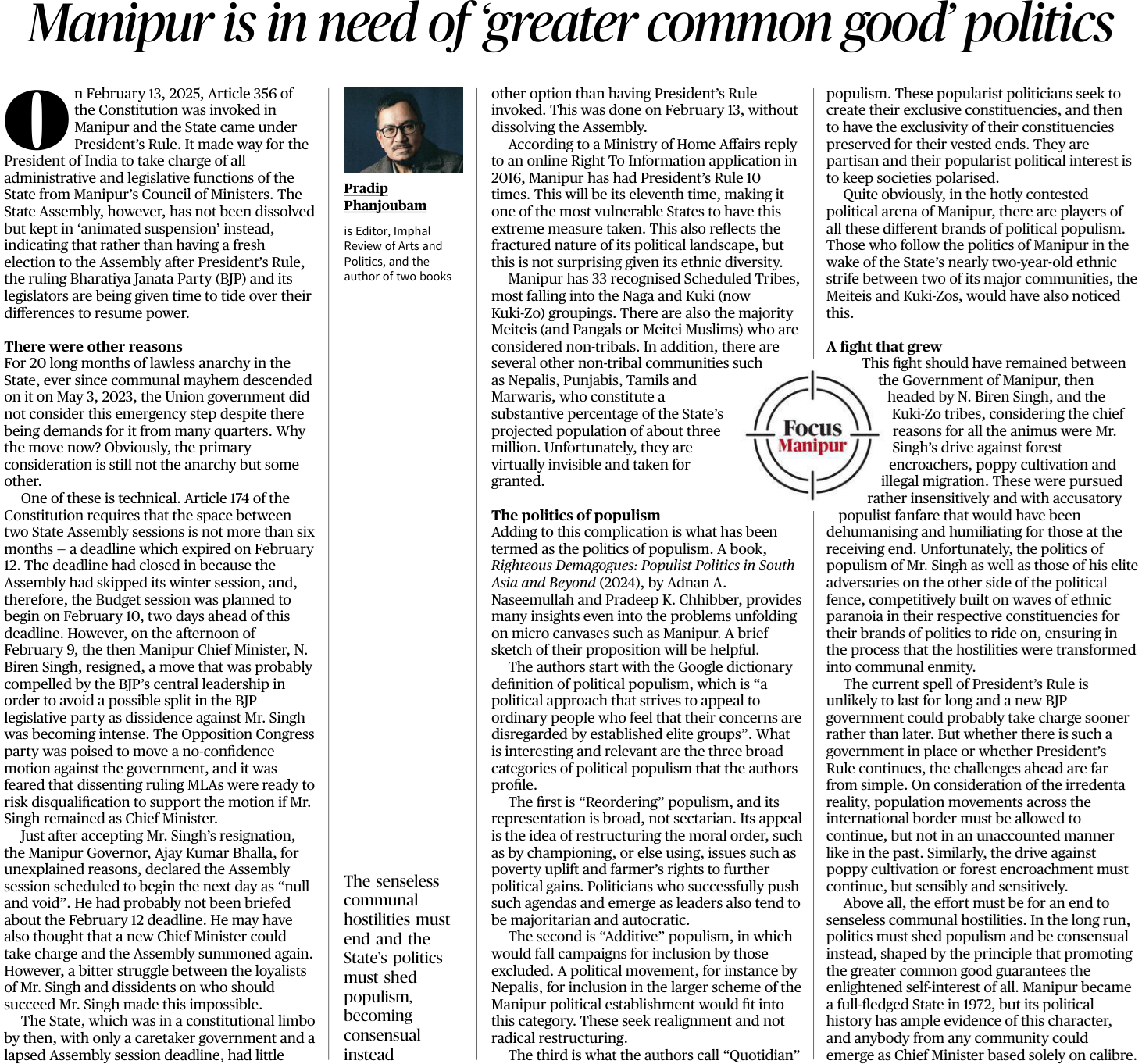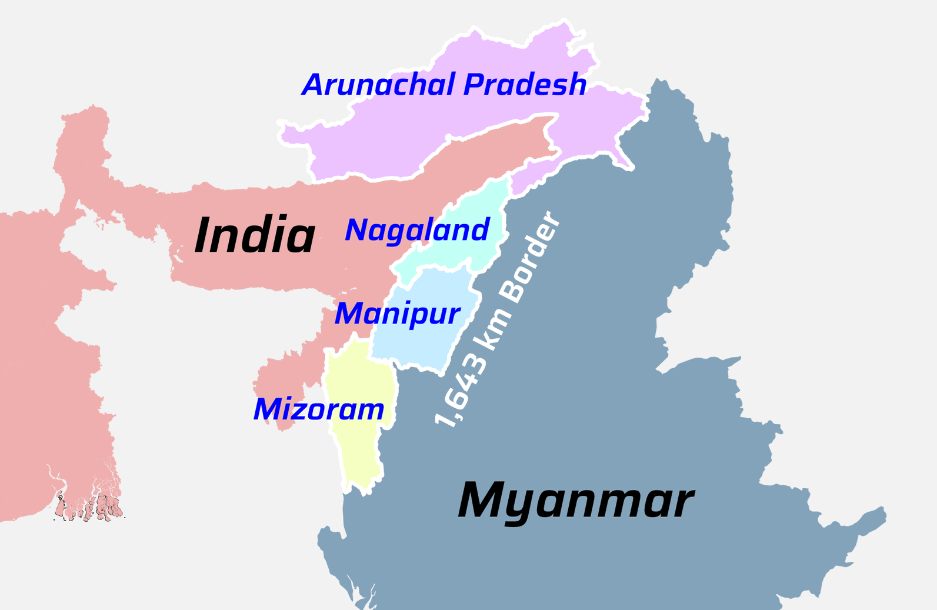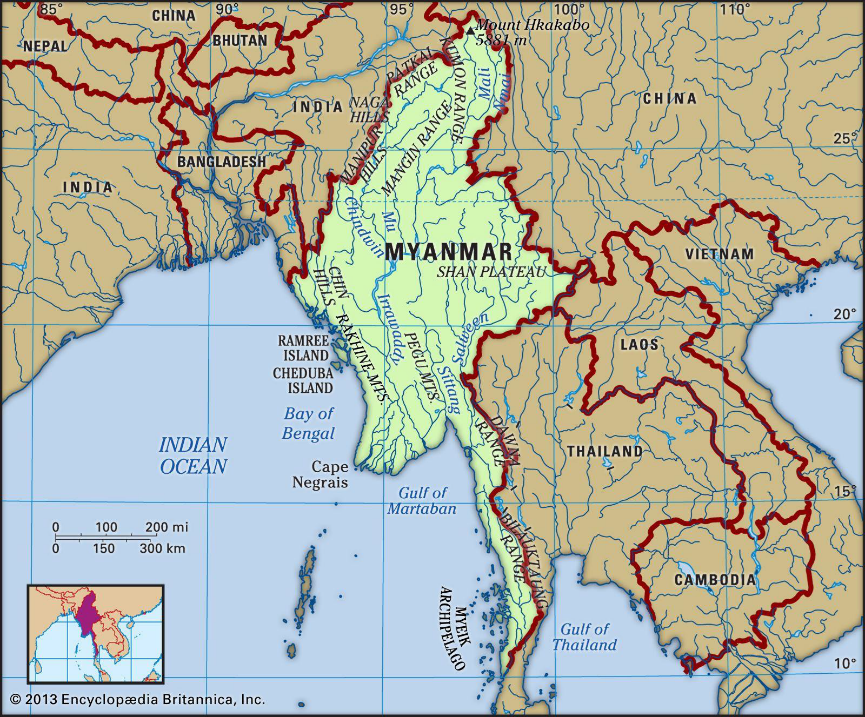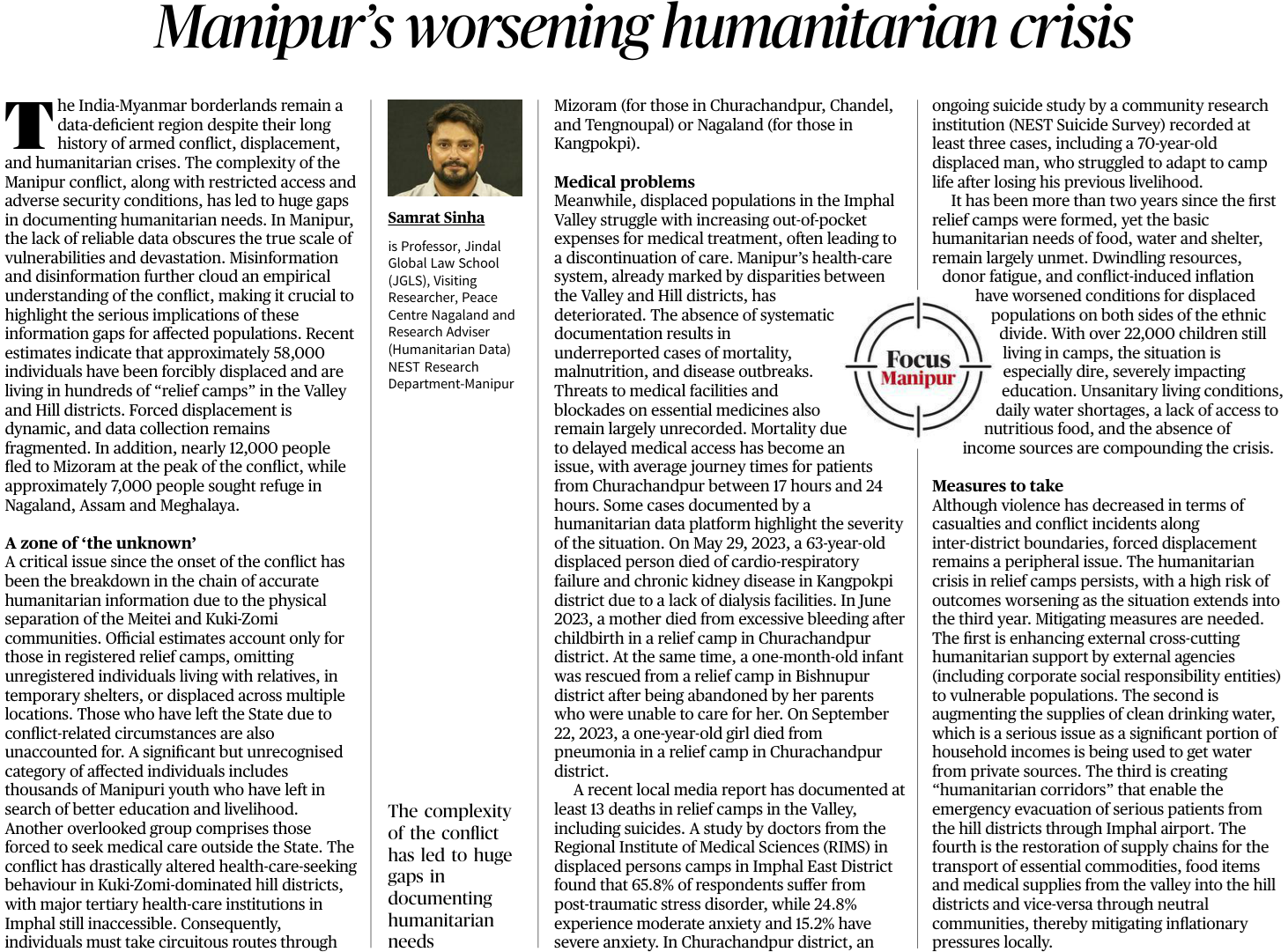1. Manipur's Political Crisis and the Need for Consensus-Driven Governance
Introduction
The imposition of President’s Rule in Manipur on February 13, 2025, underscores the political and social instability in the state. The suspension of the legislative assembly, rather than its dissolution, highlights the attempt to provide time for the ruling party to resolve internal conflicts. The decision follows prolonged communal unrest and political turbulence, raising concerns about governance, constitutional provisions, and the impact of populist politics.
Reasons for President’s Rule
- Constitutional Mandate:
- Article 174 of the Constitution requires that the gap between two sessions of a state assembly should not exceed six months. This deadline was breached, leading to the budget session being scheduled earlier than planned.
- However, political turmoil, including the resignation of Chief Minister N. Biren Singh, created uncertainty, forcing the imposition of President’s Rule.
- Political Instability:
- Long-standing ethnic conflicts between Meiteis and Kukis have exacerbated tensions.
- BJP legislators were divided, leading to governance failures.
- A no-confidence motion and dissent within the ruling party contributed to instability.
- Communal Violence and Lawlessness:
- Since May 3, 2023, Manipur has witnessed severe communal violence, which was not adequately addressed by the government.
The failure to control law and order forced the Union Government to intervene.
Ethnic and Social Complexity in Manipur
- Ethnic Diversity: Manipur comprises 33 Scheduled Tribes, including Nagas and Kukis, while Meiteis form the majority but are not classified as Scheduled Tribes.
- Neglected Communities: Other groups such as Nepalis, Punjabis, Tamils, and Marwaris remain politically marginalized.
- Recurring President’s Rule: Manipur has experienced President’s Rule 11 times, indicating persistent governance challenges.
Populist Politics and Its Impact
- Nature of Populism:
- The article highlights “Reordering Populism,” which seeks to address grievances by targeting elite political structures.
- “Addictive Populism” thrives on divisive tactics, fostering communal and ethnic conflicts for political gain.
- Populism in Manipur:
- Certain political players have fueled ethnic divisions for electoral benefits.
- The conflict between Meiteis and Kukis has been exacerbated by populist narratives rather than constructive governance.
Challenges and the Way Forward
- Restoring Governance: A new government must prioritize inclusivity and reconciliation.
- Addressing Ethnic Conflicts: Dialogue between communities is necessary for lasting peace.
- Ending Populist Politics: Leaders should focus on governance rather than divisive rhetoric.
- Ensuring Constitutional Norms: Regular assembly sessions and adherence to constitutional provisions are essential.
Conclusion
The imposition of President’s Rule in Manipur highlights deep-rooted political and ethnic tensions. While it provides temporary stability, long-term solutions require consensus-driven politics, inclusive governance, and the rejection of divisive populism. A new government must work towards sustainable peace and democratic resilience.
Bottom of FormMains Practice Question |
Q. “Discuss the reasons for the imposition of President’s Rule in Manipur and analyze the role of populist politics in exacerbating ethnic conflicts. Suggest measures to ensure stable governance in the state.” |
2. Humanitarian Crisis in Manipur: Causes, Impact, and Measures
Introduction
The ongoing humanitarian crisis in Manipur, triggered by ethnic conflict, displacement, and inadequate governance, has led to severe socio-economic and medical challenges. The lack of reliable data, restricted access, and misinformation further obscure the true extent of the crisis. As thousands remain displaced in relief camps with inadequate resources, urgent measures are needed to address the worsening situation.
Causes of the Humanitarian Crisis
- Forced Displacement:
- Around 58,000 individuals have been forcibly displaced due to the conflict, with thousands seeking refuge in relief camps.
- Nearly 12,000 people fled to Mizoram, while 7,000 sought safety in Nagaland, Assam, and Meghalaya.
- Lack of Accurate Data and Humanitarian Coordination:
- The separation of Meitei and Kuki-Zomi communities has made data collection difficult.
- Many displaced individuals are unregistered, living with relatives or in temporary shelters.
- Healthcare Crisis:
- Conflict-affected areas face a breakdown of medical services, particularly in Kuki-Zomi regions.
- Patients face long travel times (17–24 hours) to access healthcare in Imphal Valley.
- Underreported cases of mortality, malnutrition, and disease outbreaks due to lack of documentation.
- Psychosocial and Mental Health Issues:
- Studies show that 65.8% of displaced persons in Imphal suffer from post-traumatic stress disorder.
- Suicide rates among displaced populations have risen, reflecting severe distress.
- Poor Living Conditions in Relief Camps:
- Over 22,000 children remain in camps with limited access to food, water, and healthcare.
- Daily water shortages and unhygienic conditions exacerbate the suffering of displaced populations.
Measures to Address the Crisis
- Strengthening Humanitarian Support:
- Involvement of external agencies, including corporate social responsibility (CSR) entities, for relief efforts.
- Improving Water and Sanitation Facilities:
- Providing clean drinking water to reduce reliance on expensive private sources.
- Establishing Humanitarian Corridors:
- Enabling emergency medical evacuations from conflict zones to hospitals.
- Restoring Supply Chains:
- Ensuring the smooth transport of essential food and medical supplies between the valley and hill districts.
Conclusion
The humanitarian crisis in Manipur is a multifaceted issue requiring urgent intervention. While violence has decreased, displacement, medical challenges, and lack of essential supplies continue to affect vulnerable populations. Addressing these challenges through improved governance, humanitarian aid, and sustainable peace-building measures is crucial for the long-term stability of the region.
Mains Practice Question |
Q. “Examine the humanitarian crisis in Manipur, highlighting the causes and impact of forced displacement. Suggest measures to address the worsening conditions in relief camps and ensure long-term rehabilitation of affected populations.” |





